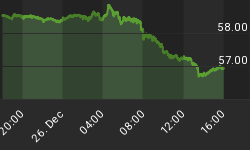Standard and Poor's has been greatly vilified for their call to lower the U.S. credit rating to AA+ from AAA. The evidence, naysayers point to, for their justification of excoriating S&P is the performance of Treasuries since the downgrade occurred. Indeed, U.S. debt yields have fallen and the dollar has increased in the five months after being stripped of AAA.
In fact, foreigners increased their holdings of Treasuries in Q3 by $17.2 billion and now own nearly 50% of our marketable debt. And 60% of their currency reserves are in U.S. dollars. So there are no signs of panic yet.
The prevailing wisdom of today now yields to the conclusion that getting your debt downgraded automatically renders a boost to your currency and bond prices. Therefore, why worry? Their comfort is ridiculously based upon the notion that the U.S. has a printing press and can create unlimited amounts of inflation. Therefore, interest rates will never rise and debt service won't ever be a problem.
I think that's also what the government of Hungary believed after WWII. They had a printing press also and it was used to pay debts accumulated during the war. But their daily rate of inflation hit a global record of over 200%. I wonder if the mortgage rates in Hungary were low back in 1946?
I, of course, strongly applaud S&P for attempting to shed a light on our pernicious debt problem. The U.S. government seems completely inept at taking even the smallest baby step towards lowering our annual shortfall in revenue over spending--let alone paying off the debt.
Recent examples of the paralysis in Washington include; the debt ceiling debate, Simpson Bowles Committee and the payroll tax holiday extension. Time after time D.C. manages to decide to increase the debt without cutting spending.
But what vindicates Standard and Poor's the most is simply the math behind the government's debt obligation. Our debt now exceeds the total GDP, and the annual deficits pile are piling on an additional $1.3 trillion each year to that accumulated debt. Our publicly traded debt has increased 100% in the last 5 years!!! What is even worse is that our debt as a percentage of revenue is exploding. Back in 1971, the national debt was 218% of revenue. In the year 2000, the debt as a percentage of revenue had grown to 280%. Today, it has skyrocketed to 700% of revenue...and if you think that is worth panicking over you are absolutely correct. Yet those ethnocentric politicians and Wall Street Banksters still believe the credit rating agency had no basis to downgrade the U.S.
The bad news is the worst is yet to come. Just wait until interest rates start to rise. The average yield on U.S. debt is near 1% today. It was 6.5% in the year 2000. But given our record level of debt and Fed-led money creation, yields on Treasuries could and should go much higher than at any other point in U.S. history. Just imagine the economic instability that will arise when yields start to soar on corporate, consumer and government debt.
So much has been written and spoken about the pristine state of corporate balance sheets. Wall Street gurus love to parrot the fact that corporations hold a record level of cash. But it is also true that those same corporations now hold a record $7.6 trillion in debt. The facts are that households, corporations and government now hold a record level of debt. And the total of that debt as a percentage of GDP is, historically speaking, extremely high and close to its record set just a few years ago. These artificial and temporary low interest rates won't last. Inflation and massive debt supply will force rates higher. Then, the economy will falter as the percentage of debt to GDP soars. Just imagine what would happen to the real estate market if mortgage rates went back to 8%, if corporations had to pay double digits to refinance their debt and if the Federal government had to roll over its $10.5 trillion in debt at 7% instead of paying 2%.
That's the reason why I believe if there is any criticism to be placed on Standard and Poor's it should be that their rating of U.S. debt is still too high; and that the downgrade came way too late.
















